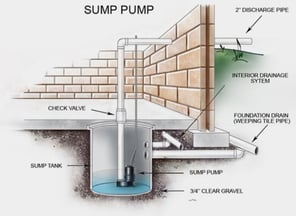 More than 60 percent of American homes have dealt with water damage in their basements. It could be caused by flooding from rainwater or snowfall, or by a break in the water heater, but it always leaves a pricey bill for property damage. An effective solution to this problem is to install a sump pump. This is a device that senses when water from rain or snowmelt is rising in the pit and approaching the floor level of your basement. The incoming water is then pumped outside into the back or side yard before it can damage your home or its furnishings.
More than 60 percent of American homes have dealt with water damage in their basements. It could be caused by flooding from rainwater or snowfall, or by a break in the water heater, but it always leaves a pricey bill for property damage. An effective solution to this problem is to install a sump pump. This is a device that senses when water from rain or snowmelt is rising in the pit and approaching the floor level of your basement. The incoming water is then pumped outside into the back or side yard before it can damage your home or its furnishings.
Sump pumps are very low maintenance appliances that still require regular inspections by the owners and professionals, such as Warner Service. The sump pump’s pit can wear out, dry out, overheat, lose lubrication or blow a circuit like any other household fixture. To help prevent this from occurring, a regularly scheduled maintenance check-up will include:
- Checking that the size of the installed sump pump is accurate for the size and needs of the house and surrounding area.
- Checking the discharge line. If it is stopped up or frozen, the hired professional will unclog the air vent hole in the line.
- Checking the inlet screen, which should also be checked by the owner 3 to 4 times per year.
- Checking the float component for smooth movement without obstruction. If it is blocked, the inspector will remove the obstruction.
- Scanning the pit and removing any debris, mud, sand or stones.
- Testing the pump.
- Checking that the water flows away from your home at a safe distance, which should be at least 20 feet.
- Checking the sump pump’s activation alarm, if available. If you have a back up system, such as a piggyback operation, back up battery or automatic generator, or a portable sump pump, the professional will also check the function of those.
An at-home rule of thumb for sump pump users is to thoroughly remove debris once a year. (If the sump pump disposes water from your washing machine, a monthly cleaning of only the inlet and pump screen is highly suggested.) This will increase the pump’s efficiency and prolong its life, which is typically between 5 to 8 years. Follow these step-by-step directions for a safe cleaning:
- Disconnect the pump from the power source by unplugging it.
- Remove the unit.
- Flush the unit with warm water to remove impurities.
- Clean debris from the sump pit with gloves.
- Reinstall the pump.
- Reconnect the pump to the power source by plugging it in again.
- Test the unit by pouring a bucket of warm water into the pit. The float should rise with the water level, which will trigger the unit to start pumping. If the pumping does not occur, the float switch or check valve may be at fault. In this case, you should call a professional immediately.
Sump pumps are especially great for areas that receive a lot of rain and snowfall combined with power outages, but to ensure their quality, the owner must perform and schedule routine maintenance checks. Feel free to use our step-by-step guide above for an at-home inspection. Also, call Warner Service today for a complete, comprehensive check-up or sump pump installation.

